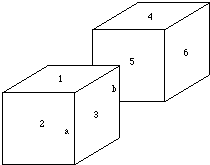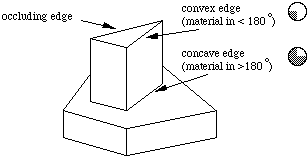


Next: Assumptions
Up: Line Labelling
Previous: Line Labelling
Line Labelling is applicable when two-dimensional lines
have been extracted from a two-dimensional image.
Initially, we shall restrict ourselves to polyhedral
objects in our scene, i.e.
have flat faces bounded by straight edges.
Under this assumption
it becomes possible to interpret the edges
- to
determine which edges bound which faces, and
- to deduce certain
relationships between faces.
Consider the line drawing shown in Fig. 41.

Fig. 41 Line drawing of two cubes
It can be seen that
- the edges bound the numbered
faces, and that faces 1, 2 and 3 belong to one cube,
- while faces
4, 5 and 6 belong to another (assuming that the two cubes are not
joined by a thin sliver that cannot be seen).
An important observation is that
- Every three-dimensional edge is
associated with exactly two faces -- one on either side of it,
- A few rather ill-conditioned objects called
non-manifold objects are exceptions -- we shall
not consider these further here.
Sometimes both of these faces can be
seen from a given viewpoint (as in the case of line a in
Fig. 41).
If only one of the faces is
visible -- the edge is called an occluding edge. On the other side of an occluding edge,
the background or a non-touching face is visible.
The basis of the line labelling method is to attempt to classify
each edge in the image as being one of:
- a concave edge,
- a convex edge,
- an occluding edge.
Edges of each type are shown in Fig. 42.

Fig. 42 Types of edge in a line drawing
Where edges meet only certain possible interpretations of the meeting lines
are mutually consistent.
This reduces the number
of possibilities for the
classification of each edge.
If a line corresponds to an occluding edge:
- It is marked with an
arrow. The orientation of the arrow gives the side of the
edge on which the visible face lies, using the convention that
the visible face lies on the right hand side of the edge, looking
along the direction of the arrow.
- Lines corresponding to convex
edges are marked with a `+' symbol.
- Lines corresponding to
concave edges are marked with a `-' symbol.
- Each edge in the
image thus has one of four possible labellings.



Next: Assumptions
Up: Line Labelling
Previous: Line Labelling
dave@cs.cf.ac.uk
